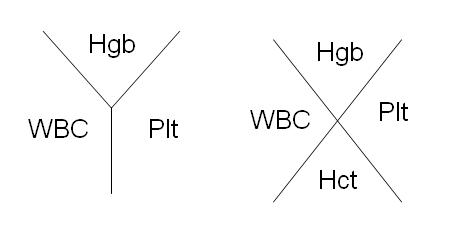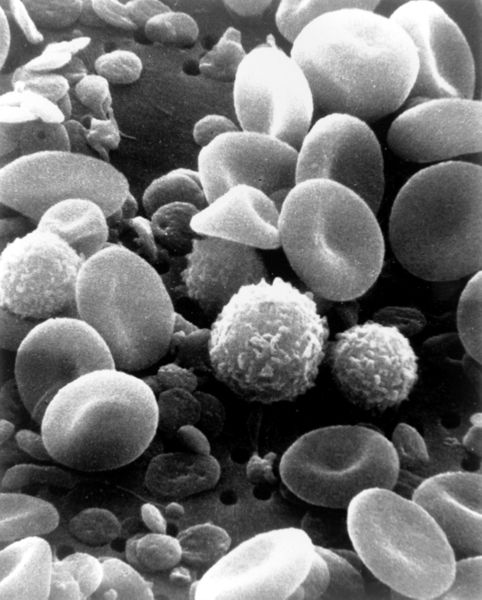Complete blood count

Editor-In-Chief: C. Michael Gibson, M.S., M.D. [1]
Overview
A complete blood count (CBC), also known as full blood count (FBC) or full blood exam (FBE) or blood panel, is a test requested by a doctor or other medical professional that gives information about the cells in a patient's blood. A lab technician (US: "medical technologist") performs the requested testing and provides the requesting Medical Professional with the results of the CBC. A CBC is also known as a "hemogram".
The cells that circulate in the bloodstream are generally divided into three types: white blood cells (leukocytes), red blood cells (erythrocytes), and platelets or thrombocytes. Abnormally high or low counts may indicate the presence of many forms of disease, and hence blood counts are amongst the most commonly performed blood tests in medicine.
Methods
Samples
A phlebotomist collects the specimen, in this case blood is drawn in a test tube containing an anticoagulant (EDTA, sometimes citrate) to stop it from clotting, and transported to a laboratory.
In the past, counting the cells in a patient's blood was performed manually, by viewing a slide prepared with a sample of the patient's blood under a microscope (a blood film, or peripheral smear). Nowadays, this process is generally automated by use of an automated analyzer, with only specific samples being examined manually.
Automated blood count
The blood is well mixed (though not shaken) and placed on a rack in the analyzer. This instrument has many different components to analyze different elements in the blood. The cell counting component counts the numbers and types of different cells within the blood. The results are printed out or sent to a computer for review.
Blood counting machines aspirate a very small amount of the specimen through narrow tubing. Within this tubing, there are sensors that count the number of cells going through it, and can identify the type of cell; this is flow cytometry. The two main sensors used are light detectors, and electrical impedance. One way the instrument can tell what type of blood cell is present is by size. Other instruments measure different characteristics of the cells to categorize them.
Because an automated cell counter samples and counts so many cells, the results are very precise. However, certain abnormal cells in the blood may be identified incorrectly, and require manual review of the instrument's results and identify any abnormal cells the instrument could not categorize.
In addition to counting, measuring and analyzing red blood cells, white blood cells and platelets, automated hematology analyzers also measure the amount of hemoglobin in the blood and within each red blood cell. This information can be very helpful to a physician who, for example, is trying to identify the cause of a patient's anemia. If the red cells are smaller or larger than normal, or if there's a lot of variation in the size of the red cells, this data can help guide the direction of further testing and expedite the diagnostic process so patients can get the treatment they need quickly.
Automated blood counting machines include the Beckman Coulter LH series, Sysmex XE-2100, Siemens ADVIA 120 & 2120, and the Abbott Cell-Dyn series.
Manual blood count
Counting chambers that hold a specified volume of diluted blood (as there are far too many cells if it is not diluted) are used to calculate the number of red and white cells per litre of blood.
To identify the numbers of different white cells, a blood film is made, and a large number of white cells (at least 100) are counted. This gives the percentage of cells that are of each type. By multiplying the percentage with the total number of white blood cells, the absolute number of each type of white cell can be obtained.
The advantage of manual counting is that blood cells that may be misidentified by an automated counter can be identified visually. It is, however, subject to human error and sampling error because so few cells are counted compared with automated analysis.
Results
For examples of standard values, see Reference ranges for blood tests#Hematology.

A complete blood count will normally include:
Red cells
- Total red blood cells - The number of red cells is given as an absolute number per litre.
- Hemoglobin - The amount of hemoglobin in the blood, expressed in grams per decilitre. (Low hemoglobin is called anemia.)
- Hematocrit or packed cell volume (PCV) - This is the fraction of whole blood volume that consists of red blood cells.
- Red blood cell indices
- Mean corpuscular volume (MCV) - the average volume of the red cells, measured in femtolitres. Anemia is classified as microcytic or macrocytic based on whether this value is above or below the expected normal range. Other conditions that can affect MCV include thalassemia and reticulocytosis.
- Mean corpuscular hemoglobin (MCH) - the average amount of hemoglobin per red blood cell, in picograms.
- Mean corpuscular hemoglobin concentration (MCHC) - the average concentration of hemoglobin in the cells.
- Red blood cell distribution width (RDW) - a measure of the variation of the RBC population
White cells
- Total white blood cells - All the white cell types are given as a percentage and as an absolute number per litre.
A complete blood count with differential will also include:
- Neutrophil granulocytes - May indicate bacterial infection. May also be raised in acute viral infections.
- Lymphocytes - Higher with some viral infections such as glandular fever and. Also raised in lymphocytic leukaemia CLL.
- Monocytes - May be raised in bacterial infection
- Eosinophil granulocytes - Increased in parasitic infections.
- Basophil granulocytes
A manual count will also give information about other cells that are not normally present in peripheral blood, but may be released in certain disease processes.
Platelets
- Platelet numbers are given, as well as information about their size and the range of sizes in the blood.
Interpretation
Certain disease states are defined by an absolute increase or decrease in the number of a particular type of cell in the bloodstream. For example:
| Type of Cell | Increase | Decrease |
|---|---|---|
| Red Blood Cells (RBC) | erythrocytosis or polycythemia | anemia or erythroblastopenia |
| White Blood Cells (WBC): | leukocytosis | leukopenia |
| -- lymphocytes | -- lymphocytosis | -- lymphocytopenia |
| -- granulocytes: | -- granulocytosis | -- granulocytopenia or agranulocytosis |
| -- --neutrophils | -- --neutrophilia | -- --neutropenia |
| -- --eosinophils | -- --eosinophilia | -- --eosinopenia |
| Platelets | thrombocytosis | thrombocytopenia |
| All cell lines | --- | pancytopenia |
Many disease states are heralded by changes in the blood count:
- leukocytosis can be a sign of infection.
- thrombocytopenia can result from drug toxicity.
- pancytopenia is generally as the result of decreased production from the bone marrow, and is a common complication of cancer chemotherapy.
References